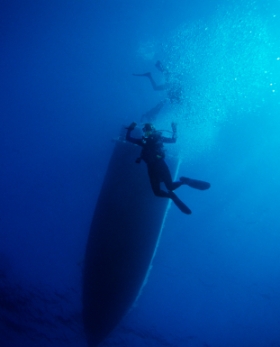Magistrate Judge Facciola’s “Christmas Eve” opinion now has a sequel: Covad Communs. Co. v. Revonet, Inc., 2009 U.S. Dist. LEXIS 47841 (D.D.C. May 27, 2009). This opinion is very detailed covering issues of forensic examinations, email servers and commentary on retention policies. I encourage lawyers to look at this opinion.
The issues in Covad II were the following:
(1) Whether Plaintiff Covad Communications Company could conduct a forensic search of Defendant Revonet, Inc.’s computers and servers;
(2) How those searches should be conducted; and
(3) Who should pay the cost? Covad, 1.
The crux of the lawsuit was the expropriation of information from Covad by Revonet, who ran made an outbound phone marketing campaign. Covad, 1-3.
Taking the Deep Dive
 Judge Facciola is no stranger to wading deep into the waters of detailed facts and technical requirements for preserving, searching and reviewing electronically stored information.
Judge Facciola is no stranger to wading deep into the waters of detailed facts and technical requirements for preserving, searching and reviewing electronically stored information.
This time around, the judge put on a cold water survival suit jumped into Antarctic waters.
This case involved a complex set of facts to image multiple servers, complete with failures over the years, different back ups, located in New Canaan and Sioux Falls. Covad, 5-9.
The findings of fact were 14 paragraphs from three hearings, plus a page and a half grid accounting for the lives of different hard drives and servers. Covad, 10-11.
The Heart of the Lawsuit
The “heart of the lawsuit” was not limited to the original “Federated Database” that the Defendants used for outbound and inbound leads, but the electronically stored information outside of the marketing campaigns to show what the Defendants did with the ESI. Covad, 13.
The Plaintiffs argued they needed a forensic image to search the database’s historical data. Covad, 12.
The Defendants fought against a full forensic image and argued only two of the marketing campaigns were at issue. Covad, 12.
The Court sided with the Plaintiffs.
Forensic Searches of Databases
 The issue of forensic image and forensic searching of the databases launched an in depth review of Federal Rule of Civil Procedure Rules 26 and 34.
The issue of forensic image and forensic searching of the databases launched an in depth review of Federal Rule of Civil Procedure Rules 26 and 34.
Federal Rule of Civil Procedure Rule 34 allows for the copying of electronically stored information, limited by Federal Rule of Civil Procedure Rule 26(b)(1) to “any non-privileged matter that is relevant.” Covad,12.
The Defendants claimed because the database had “confidential” material, imaging was not appropriate. Covad, 12. The Court disagreed. Any issues regarding confidential material could be addressed with a protective order, which was not a reason to bar a forensic image. Covad, 12.
Federal Rule of Civil Procedure Rule 34 is not an express way to an opponent’s hard drive. The Advisory Committee notes, followed by case law, have put the breaks on making the default standard forensic examinations of hard drives. Covad, 13, citing Fed. R. Civ. P. 34, Advisory Comm. Note (2006). Additionally, because of confidentially and privacy issues that I have seen judges cringe over, “compelled forensic imaging is not appropriate in all cases, and courts must consider the significant interests implicated by forensic imaging before ordering such procedures.” Covad, 13 (citations omitted).
The Court explained that the issue of forensically inspecting a party’s hard drive was subject to the balancing test of Federal Rule of Civil Procedure Rule 26(b)(2(C) because of undue and unnecessary burden. Covad, 15-16.
The Defendants claimed undue burden because their servers were “old” and could crash. Covad, 16.
The Court rejected the Defendants’ arguments. First, the forensic imaging was ordered to be done over a weekend, as to avoid interfering with business operations. Second, the searches were to be done on the forensic copies, so the databases would not be affected. Third, the forensic images and searchers were to be covered by a protective order. Covad, 16.
The Court found that the balancing requirements under Rule 26(b)(2)(C)(iii) established that the benefit of forensic examination outweighed any burden, considering the amount in controversy and the issues at stake. Covad, 16-17. The Court noted this case was also a paradox, because allowing the discovery was the only way to determine the “amount in controversy,” “the likely benefit,” and the “needs of the case.” Covad, 17.
Judge Facciola ordered the databases to be forensically imaged based on the overwhelming necessity for the discovery. Covad, 18. Now, the email was a different story.
Email Servers
The Plaintiffs sought the forensic examination of the Defendants’ email servers because 1) the email production was incomplete; 2) the email production suggested the Defendants used email to pass leads onto clients; and 3) the Defendants’ email servers crashed after the litigation began, but before discovery. Covad, 19.
The Court cited examples of companies poor document retention and destruction policies, plus examples of different individuals saving more email than another coworker, as possible ways gaps in email can occur. Covad, 20-21. The Court further stated:
…I cannot find any authority in the cases to date that permit a court to conclude that allegations of deficiencies in themselves automatically require a forensic search whenever a party claims that there are, for example, fewer e-mails from a person or about a subject or transmitted in a given time than the party expected to find. This would result in forensic examinations in virtually every case, which would increase the cost of litigation involving electronically stored information markedly not only because of the cost of the examination itself, but also because it would yield information that would have to be sorted for relevance and privilege. Experience shows that the latter, involving expensive reviewing of “e-mail strings” by lawyers, paralegals or by vendors to whom the work has been outsourced, may dwarf the cost of the search. Covad, 21-22.
The Court stated that the forensic search of email servers should require a showing that a producing party did not meet their Rule 26(g) production requirements that the production was “complete and correct as of the time it was made.” Covad, 22, citing Fed. R. Civ. P. 26(g)(1)(A).
The Court “reserved judgment” on imaging the email servers, because
1) The forensic examinations that were being allowed might produce evidence of how email was used to pass on leads; and
2) The Defendants repeatedly asked the Plaintiffs for suggested search terms, which went unanswered. Covad, 22-23.
Who Pays the Bill?
Magistrate Judge Facciola’s discussion on costs is worth reading in its entirety.
 The Court noted that the expansion of technology and storage media has created the “antithesis” of a records management policy: People save everything. Covad, 29.
The Court noted that the expansion of technology and storage media has created the “antithesis” of a records management policy: People save everything. Covad, 29.
This phenomenon causes increased costs in collection, processing and review of electronically stored information. As the Court stated:
[N]ew technologies have the capacity to be outcome determinative but often at significant expense. Thus the courts are required to strike a balance between allowing the requesting party to take full advantage of the technologies available to it and protecting the producing party from having to pay to leave no stone unturned. Resting all of the costs of electronic discovery on the producing party may create a perverse incentive on the part of the requesting party to dispense with reason and restraint and unleash every new technology under the sun to try and find information that supports the requesting party’s claims. 29-30.
The Court held the Defendants were required to pay the production costs, but specifically limited to the forensic copy. The Plaintiffs were required to pay for their own expert to review the produced forensic copies. Covad, 30.
Bow Tie Thoughts
This is a very well thought out opinion that covers many issues for the forensic imaging of databases, servers and costs. This blog posting does not cover every issue and the opinion is definitely worth reading.

I have been following this case for some time. This is a very well thought out article, thank you.